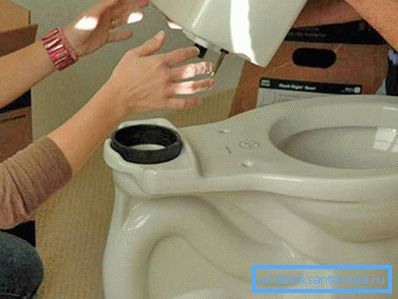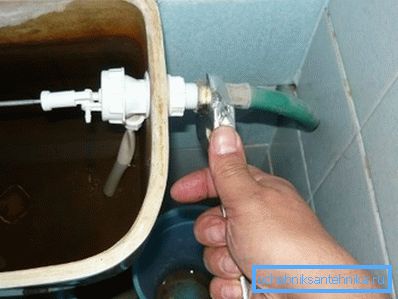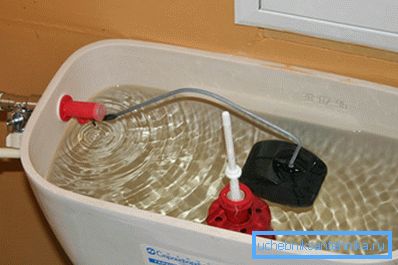What to do if the toilet is leaking: simple solutions to a
Noticed that moisture accumulates around the toilet, and do not know how to fix this problem with your own hands? We will give the answer to this and related questions in this article, because a modern comfortable house is inconceivable without functional and high-quality sanitary ware. And her good condition guarantees an optimum level of life comfort.
But, sooner or later, the plumbing equipment loses its efficiency and requires reconditioning. Such devices, sooner or later, break down, and you will either have to call a professional plumber or fix the problem yourself. Considering what the price of plumbing services is, it is preferable to do the work yourself.

The most likely leak points

Instructions to eliminate leakage depends on their location. Therefore, before proceeding with the repair, you need to find out the origin of moisture.
Among the most likely places of leakage, we note the following:
- connection of plumbing flexible hose and inlet fittings;
- connection of the inlet fittings and the drain tank (or the place where the plug is installed);
- tank and bowl connection on toilet compacts;
- connection of toilet bowl and sewer pipe;
- microcracks on the inner or outer surface of the bowl;
- manufacturing or shipping defects in the form of chips.
Find the cause of excess moisture in your toilet, among the listed categories? In this case, it's time to start solving the problem.
Leakage at the point of connection of the plumbing hose and inlet fittings

Does the water continuously leak at the point of connecting the plumbing flexible hose and inlet fittings? To solve this common problem, you will need a wrench or adjustable wrench and a number of available consumables, such as gaskets or a hose.

Repair is performed as follows:
- Use a pipe wrench or wrench to tighten the nut, which could not be tightened during installation of the hose. Most often, this type of leakage happens precisely because of a loose adjacent gasket.
Important: The nut must be tightened, but not tightened. If you apply excessive force, you can break the thread, and also ruin the gasket.
- You may have to purchase a new gasket if the installed consumables are damaged or due to old age do not provide adequate tightness.. To replace the gasket will need to shut off the water supply to the tank, unscrew the flexible hose and replace the consumables.
- You may need to purchase a flexible hose if the connector already installed has micro cracks at the bend points.
Important: When buying a new hose, try not to save and buy only high-quality and reliable products that you will not have to change in six months.
Leakage at the site of connection of the drain tank and inlet fittings
The presence of leaks at the junction of the flush tank and inlet fittings is a common problem.
Often this problem is confused with the effects of condensation on the surface of the tank. If the leakage is not fixed within a year or more, a darkening in the form of a drip will be swept up at the place of a poor-quality connection on the tank.
The problem is fixed as follows:
- We tighten the intake fitting nut to the tank using a wrench. The cause of leakage in this case is the loose connection of the gasket and, as a result, the flow of water. Such a problem is especially relevant if the bottom water supply is used when mounting the tank.
- If the gasket is damaged or missing at the junction of the fittings and the tank, you can prevent the leakage of water as follows.
Shut off the water, unscrew the flexible hose and nut that secures the valve. We look at the type of gasket and acquire a new analogue. Then install the new gasket in place worn out, and assemble the entire structure in reverse order.
- With lateral supply, leakage is possible due to an unregulated shut-off valve and too high water level in the tank.

Fix the problem by removing the tank cover and lowering the float a little by means of the fixing screw. As a result, the water supply will overlap until it reaches a critical level.
Tip: When setting up the float, do not be lazy to check the quality of the gasket, and if it is damaged or not tight, replace it with a new gasket.
- Leakage, due to the high level of water in the tank, can be caused by a fuzzy triggering of the diaphragm valve due to the poorly assembled water intake fittings. In this case, it suffices to dismantle all valves and check how tightly all threaded connections are made.
- Leaks due to high water levels in the tank can be caused by the failure of the diaphragm valve.. This problem often occurs if the water supply is lateral. An effective way out of this situation is the complete replacement of valves (on average once every 5 years).
Leakage at the junction of the toilet bowl with a sewer pipe and bowl with cistern
If water flows at the junction of the cistern and the toilet bowl, the causes of the problem and, accordingly, the solutions can be as follows:
- If the nuts of the fastening bolts are unscrewed during use or not tightened enough, you need to shut off the water supply, remove the cover and tighten the nuts with a special wrench.

Perhaps the steel fasteners during the application rusted. In this case, the attachment should be cut with a hacksaw. And in general, when assembling plumbing, try not to use metal fasteners without galvanizing.
Tip: In order for the nuts on the mounting bolts during operation not to be unwound, using the toilet, try not to put pressure on the tank with your back.
- Leaking at the junction of the bowl and the tank may be caused by improper installation of the rubber gasket. You can fix the problem by completely disassembling the connection, and correcting or completely replacing the gasket.

- The leakage of water at the point of connection of the bowl outlet and the funnel pipe can be caused by a poorly sealed joint of the connecting elements.
The problem of a leaky joint is characteristic of cast iron pipes. The solution is to dismantle plumbing, cleaning the joint and making the joint using modern sealants.
Important: At the end of the joint seal, the system is not recommended to be used during the day.
Now that we know what to do if the toilet bowl is leaking, it would be nice to decide how to deal with cracks and chipped cups.
Sealing of microcracks

Noticed a small crack in the faience and believe that it is causing leakage? In this case, shut off the flow of water into the tank and dry the surface of the crack with a hairdryer. Next, we treat the area around the crack with sandpaper to form a roughness and a small recess.
We dissolve a two-component adhesive based on epoxy resin and apply with a thin layer in place, treated with sandpaper. A day later, the dried glue is leveled with fine-grained emery paper and you can start using the toilet bowl.
Conclusion
Now, when you know what to do, if the toilet flows from the bottom, you can also take up the elimination of other faults plumbing in the toilet. To significantly simplify the task, watch the video in this article.